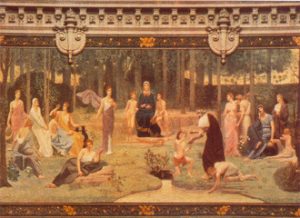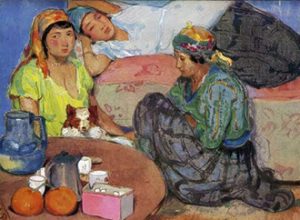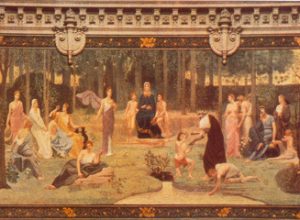
Society is not immune to what Richard Thomson calls a visual culture that in turn plays upon people’s mentalities. In the case of the French Republic between 1889 and 1900, he sees an opportunity to depart from the established categories of art history, which often limits itself to studying avant-gardes while downplaying the notion of the subject. What he discovers in the way of a connection between images and the societal debates is of precious value: there is the decadence of the nation, of the nation’s body; the nagging desire for revenge against Germany (art works showing this much more than literature); the creation of Darwinian representations of the crowd and of the working classes, the dangerous classes; the religious question, at the very moment when the Republic, weakened by the Boulangist crisis and the Dreyfus Affair, had to soften its anticlerical positions; and the emergence and spread of signs of a kind of sexuality whose harshness and crudeness offered a reflection of relations between men and women. None of all that remained alien to art, which was less an illustration than a reservoir of strong sensations and new manners.
With Thomson’s aid, it is not difficult to grasp how wrong it would be for us to treat the world of forms in isolation, sparing it the weight of history. This world does not follow upon political, social, and economic history but acts, rather, in accordance with its own tendencies and rhythms. And while it is affected by the times, it plays just as largely upon its influence over the forward march of societies. The author has broken down the barriers between the various fields of the human sciences in order to arrive at an original history of people’s mentalities. We should be delighted that his book, The Troubled Republic: Visual Culture and Social Change in France, 1889-1900, is to be translated and published in France. Rodolphe Rapetti, renowned for his writings on nineteenth-century art, responds to him after his own fashion, recalling to what extent there exists genre of original art history that revitalizes our view of an apparently already well-known object.
Laurence Bertrand Dorléac
Seminar of May 4th, 2006
Rodolphe RapettiNew Look at the Concept of the Image on Late Nineteenth-Century Art
When devoted to a specific time period, two types of works are produced in the history of art: those that, by offering new information, allow us to nourish our thinking with previously unknown examples, but without, for all that, changing our view of the topic at hand, and those that redefine this topic, thanks to the originality of a special point of view. Richard Thomson’s book belongs to the second category, that of publications which, for years to come, mark a milestone in how a period is approached, and in which the student or the researcher will be led to find ideas likely to fuel substantive debate.
There is, in the title of Thomson’s book, The Troubled Republic: Visual Culture and Social Debate, 1889-1900, the announcement of a program. Let us note, first of all, that the relatively limited period on which this book bears includes a wealth of stylistic upheavals of all kinds and appears to be one that, by its very essence, is difficult to make out in its diversity. The author’s goal is to analyze the different ways in which art expressed certain social and political aspects of the Third Republic and to find out how, in turn, images were able to exert an influence over society. While Naturalism becomes here, as one might expect, the object of a major reevaluation and while many pictures which once had place of pride in our history textbooks and in our provincial museums are rescued from oblivion by their inclusion in his copiously illustrated pages, the author does not limit himself solely to artists whose intentions and statements were connected in clear-cut ways to social and political questions. Impressionists, Symbolists, and Nabis also are made the object of detailed and erudite analyses. Through these analyses, one gradually discovers that the notion of the painting’s subject, which had been evacuated by Formalism in the twentieth century, definitely remained present in works one had been taught to consider only in terms of their plastic-art meaning. Thus, for example, by relying on an in-depth knowledge of late nineteenth-century literature and by making use, in particular, of a text by the columnist Léo Taxil, the author is able to decipher allusions to lesbianism in Le Rond-Point des Champs-Elysées (1889, p. 39), one of the most famous pastels by Louis Anquetin, a major artist of Cloisonnism whose work has until now only rarely or superficially been the object of iconographic analysis.
This observation of different forms of interaction between art and society is basically founded upon the documentary method. Instead of offering a vast panorama of his topic, Thomson fastens upon significant examples presented in a special light. Without ever losing contact with the argument in his text by making tiresome and overlong digressions, the author nevertheless sticks to the general historical context, biographies, and political ideas of the various artists examined, endeavoring to describe the expository structures of their works and the dissemination thereof as well as the practical stylistic details on which an ongoing search for novelty, characteristic of this period, was based. This meticulous restoration of the context in which the work of art was perceived casts revealing light upon a fin de siècle period that, notwithstanding an increasing number of works over the past twenty years, remains relatively neglected or at least still fragmented among the specialized disciplines of history, social history, art history, and the history of literature. Thomson, by way of contrast, lets these different disciplines communicate with one another. The rare instances where we have seen comparable attempts–such as René Jullian’s Le Mouvement des arts du romantisme au symbolisme (1979)–which were more concerned with being exhaustive and always focused on more extended periods of time, exhibit less detailed approaches to their subject matter. His work, and this is not the least of its merits, does indeed benefit from firsthand knowledge of forgotten literary texts and of works of art, some of which are lost in the back of museum storerooms or decorate the staircase of some subprefecture building. Similarly, this work also demonstrates that its author is perfectly well informed about the most recent publications concerning the major artists of the period. His view of the end of the nineteenth century thus presupposes an abolition of the binary division between formally innovative artists and those who upheld or followed tradition. Indeed, nineteenth-century historiography has long been based upon precisely this division.
The main originality of Thomson’s book resides in its structure. Far from exhibiting a superficial search for unity, it audaciously divides its subject into four major iconographic themes. In each of the book’s four chapters, the notion of the image is confronted on the one hand and as regards the most conventional sorts of artistic production, with the necessities of its social function, and, on the other, with the freer position innovative artists were to adopt in relation to this notion. Moreover, analysis of these different themes rests on a constant to-and-fro movement between public sphere and private sphere. Thus, the first chapter sets up a confrontation between public images of the human body and intimate, erotic representations thereof. The second one, which is devoted to the theme of the crowd, puts a commemorative painting like Alfred Roll’s Le 14 juillet 1880 (p. 112) into perspective along with the crepuscular urban visions of the Symbolist Charles Lacoste (pp. 104-105) and Vallotton’s wood engravings (p. 109), which show the Parisian crowd battling with the authorities. Here, one can see quite well the way in which Baron Haussmann’s city planning could have given birth not only to the modern city but also to the modern crowd, wherein the individual falls into line and steps back so as to blend into an ambivalent mass, either well policed and orderly or openly hostile, depending upon the circumstances. The author does not confine himself to painting but sets out, instead, to explore the phenomenon of how different artistic disciplines influence one another as well as the interferences that can take place between art and people’s mentalities. Sculpture, posters, prints, photography, and architecture, but also bodily postures and clothing habits, are taken into account. The last two chapters broach, from different angles, the question of the persistence of the notion of historical painting at the very end of the nineteenth century. One of those chapters is devoted to the relations between art and the sacred and concerns the debates convulsing the Church and the State on the topic of religious art and Catholicism’s revival in Symbolism as well as the anticlerical current. The other one raises the problem of painting military subjects in a nation traumatized by the war of 1870 and brings out the subterfuges by which, through the use of images, artists tended to transform this defeat into hope for victory.
Some of the questions posed by Thomson prove to be quite topical. Let us take up here just one example, that of images of eroticism (chapter 1). The nineteenth century witnessed the invention of advertising, which came to shatter the status of images. This period also invented modern sexuality, with all that that presupposes in the way of interferences between one’s private world and the public world. Nowadays, this theme in art has gained such an importance, be it only in quantitative terms, that it is worthwhile wondering about its remote sources. The second half of the nineteenth century did indeed witness the progressive decline of the gallant world of old and the appearance of a sexuality tinged with severity and irony, in the tradition of Rops and Baudelaire, while sexual imagery began to undergo increased circulation and affected, especially, the artistic sphere. The examples of Degas (commented on, in particular, by Félix Fénéon), Rodin, Bonnard, and Charles Maurin here become the object of especially pertinent analyses that relate changes in mores to a minor literature that has by now been forgotten but that at the time authorized a new approach in certain quite famous paintings, like those of Toulouse-Lautrec. Thomson rightly makes use of Max Nordau’s work, Entartung (1892), which was translated quite soon into French, as the basis for reflecting upon the idea of decadence that underlay Third Republic society’s take on its own moral outlook. Nordau’s book Degeneration was indeed one of the linchpins in the relationship between individual psychology and such mass phenomena as could be described at the time in newspapers and novels. The notion of decadence–which one will see being used during this period by literary critics before a few poets, including Verlaine, began to champion it by giving it a positive meaning–had been the object of speculations of a sociological nature that were based upon prior medical research. Nordau had read Cesare Lombroso, whose L’Uomo delinquente (Criminal man, 1876) had indeed been translated into French as early as 1887. The likening of the national body to an individual suffering from a disease was then a commonplace. It is curious that Nordau, whose approach fit into the positive sciences, would have placed such a large emphasis on art and literature as symptoms of the degeneration he was diagnosing in society at the time. Here we have a paradigm shift that in itself offers a validation for Thomson’s approach, based as it is on a rigorous analysis of displacements of the borders between art and that on which art is nourished.
The genuine subject of this book resides in its study of the phenomena of porosity among fields we had been taught in the history of art to define as autonomous, or at least rather clearly separate. The reflection carried out here as concerns a limited period of time can in this way help to open up broader perspectives for ourselves. Thomson restores the concept of the image to its genuine place in late nineteenth-century art.
Richard Thomson is Head Curator of the French National Heritage. He has been the Curator at Paris’s Musée d’Orsay and then Director of the Museums of Strasbourg. He is presently Deputy Director of the Museums of France. Rapetti has taught at the School of the Louvre, as well as at the University of Paris-X (Nanterre), and has published numerous books and articles devoted to nineteenth-century art. In addition, he has been asked to be the curator of several exhibitions, including “Munch and France” (Musée d’Orsay, Paris, 1991-1992), “Gustave Caillebotte” (Grand Palais, Paris, 1994-1995), “Eugène Carrière” (Museums of Strasbourg, 1996-1997), and “The Unknown Horizon: Art in Finland, 1870-1920” (Museums of Strasbourg, 1999).
Rapetti is the author of the following works : Le Symbolisme (Paris: Flammarion, 2005), Americans in Paris, 1860-1900 (London: National Gallery, Boston: Museum of Fine Arts, and New York: Metropolitan Museum of Art, 2006-2007), Auguste Rodin–Eugène Carrière : Interférence (Tokyo: National Museum of Western Art and Paris: Musée d’Orsay, 2006).



